FOLLOW OUR STORY
Over 320 years of curious & intricate History, read and learn all about the founding of The Church in 1699 all the way up to the custodians of the Church today.




In Dublin, history comes alive
Built at the beginning of the 18th century, the building boasts many outstanding features and significant cultural and political associations, such as the Renatus Harris built organ and spectacular stained glass window. The building ended it religious period 1964 and lay derelict for a number of years until it was purchased by John Keating in 1997.
Following extensive restoration over a seven year period, this List 1 architectural masterpiece finally re-opened its doors in December 2005 as John M. Keating’s Bar. The tasteful conversion and refurbishment was acknowledged at the Dublin City Neighbourhood Awards 2006, where it won first prize in the category of Best Old Building.
In September 2007 the building was acquired by new owners and renamed. The minister for Arts, Heritage, Gaeltacht and the Islands has classified the building as one of intrinsic historical interest in Ireland.
Today, the custodian of the building, Brendan Flynn, continues the upkeep and sensitive maintenance of The Church and is fully invested in its cultural and historical significance and well as its place in the modern fabric of Dublin’s complex social scene.
Here at The Church we are extremely proud of our unique connection with some of Dublin’s literary greats. Some of the world’s most prolific writers were born and raised in our great city. As a world recognised endorsement Dublin is the fourth UNESCO City of Literature.
The Architecture
Source: The National Inventory of Architectural Heritage
Saint Mary’s (former) Church of Ireland was begun c.1700 to the design of Sir William Robinson and was completed by his successor, Thomas Burgh. It was the first classical parish church in the city and was the site of Arthur Guinness’s marriage in 1761. Wolfe Tone was baptised here and the church also witnessed John Wesley’s first Irish sermon.
The triumphal east window was designed at least in part by Robinson and has a grace and vivacity unusual in a city largely bypassed by Baroque influences. The style is supported by the tracery windows and represents the only extant exterior Baroque flourish in Dublin city. The plan form adds further to the site’s unique identity, with the convex quadrants being a departure from the usual rectilinear shapes found in similar churches, contributing a distinctive design and striking presence.
The Ionic doorcase and original doors to the west end are of notable significance, the composition in calp limestone and sandstone offers a very early aspect which, in conjunction with the segmental pediment and convex frieze, grounds the building in its historical context and creates a unique façade.
The galleried interior is one of the earliest in Dublin, and is a triumph of Classical timber design. Grand proportions combine with the set-pieces of the original organ case, east window and surviving Corinthian reredos, connected by an ornate mix of joinery and innovative modern alterations, to create a sumptuous and exuberant space.
Mary Street was laid out by Humphrey Jervis from the mid-1690s and in 1697 the parish of Saint Michan’s was divided into three which precipitated the construction of Saint Mary’s. Jervis Street was named for the developer himself and was once home to seventeenth and eighteenth-century buildings. The streets are much altered now and consist largely of Victorian buildings, leaving Saint Mary’s to ground the district in its earlier historic milieu. As such, it makes a highly significant contribution to the streetscape and to Dublin’s overall architectural fabric.
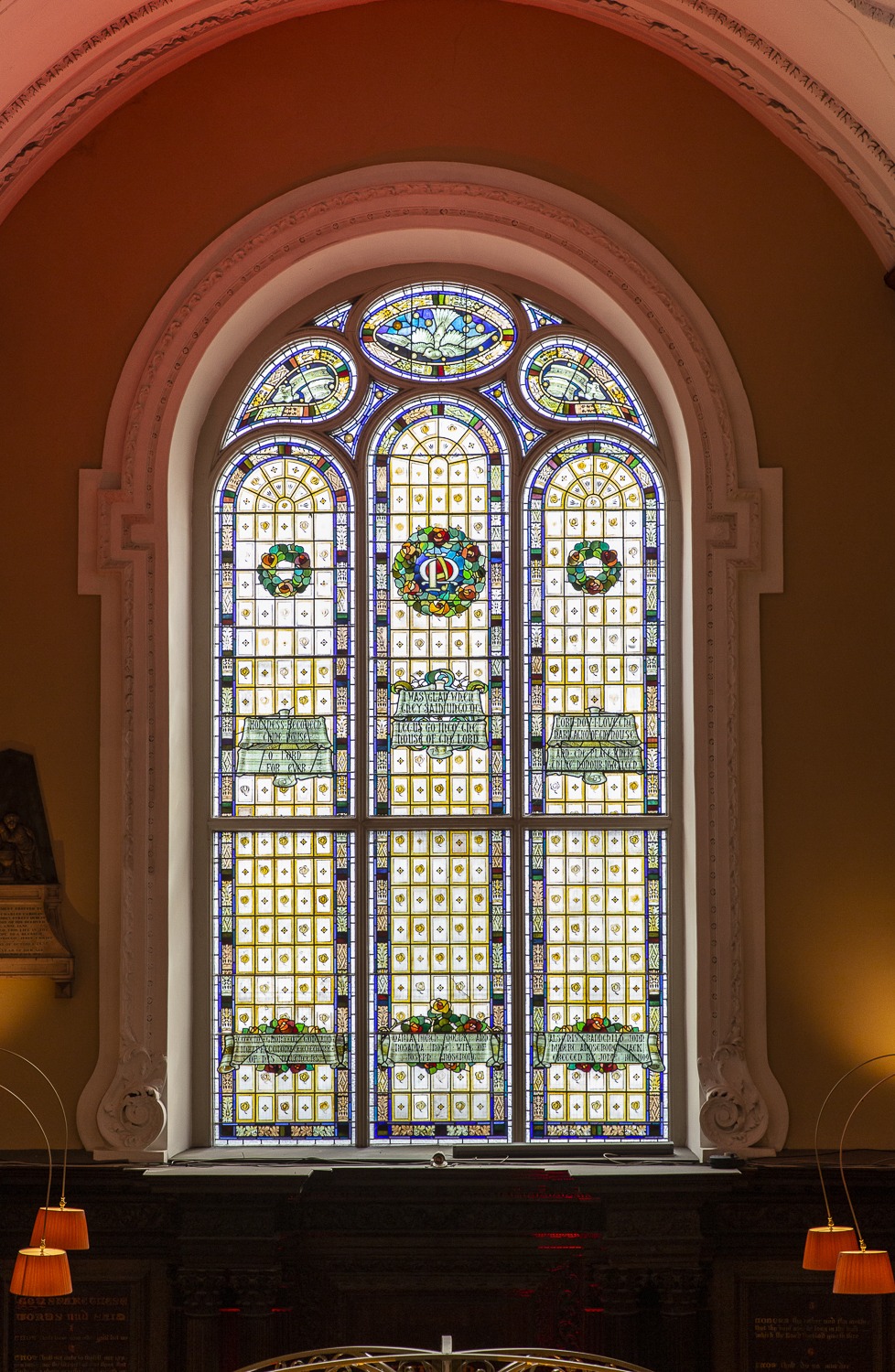
The Notable and Notorious
Arthur Guinness married Olivia Whitmore in St Mary’s in 1761.
Notable baptisms in the church include:
Playwright Seán O’Casey in 1880 (The Plough & The Stars, Juno & The Paycock & The Shadow of a Gunman)
Theobald Wolfe Tone in 1763. (Wolfe Tone was born at 44 Stafford Street nearby. Stafford Street was later renamed after Wolfe Tone.).
James Caulfield 1st Earl of Charlemont and Commander-in-Chief of The Irish Volunteers (1780) was baptized in the church in 1728,
The Irish satirist and playwright Richard Brinsley Sheridan in 1751 (The Rivals, The School for Scandal, The Duenna and A Trip to Scarborough.)
Records show that burials in the church vaults include Anne, daughter of the Bishop of Meath (interred 14 December 1725), the Rev Rawlinson Foord (also interred 14 December 1725), and Charles Campbell (interred in the chancel vault 2 November 1765).
All the remains of those in the vault or crypts were later cremated and placed at St. Michans. This process was supervised by a Dublin Corporation Environmental Officer in consultation with the Representative Body of the Church of Ireland.
The adjoining churchyard is the final resting place of the United Irishman Archibald Hamilton Rowan (1751–1834), Mary Mercer, founder of Mercer’s Hospital (died 1734), the philosopher Francis Hutcheson (1694–1746), Sir Boyle Roche, 1st Baronet (1736–1807), an Irish politician and member of the Irish House of Commons, parish rector William Fletcher (1715–1771), and Lord Norbury 1745–1831; known colloquially as the hanging judge) who ordered the execution of Robert Emmett in 1803.
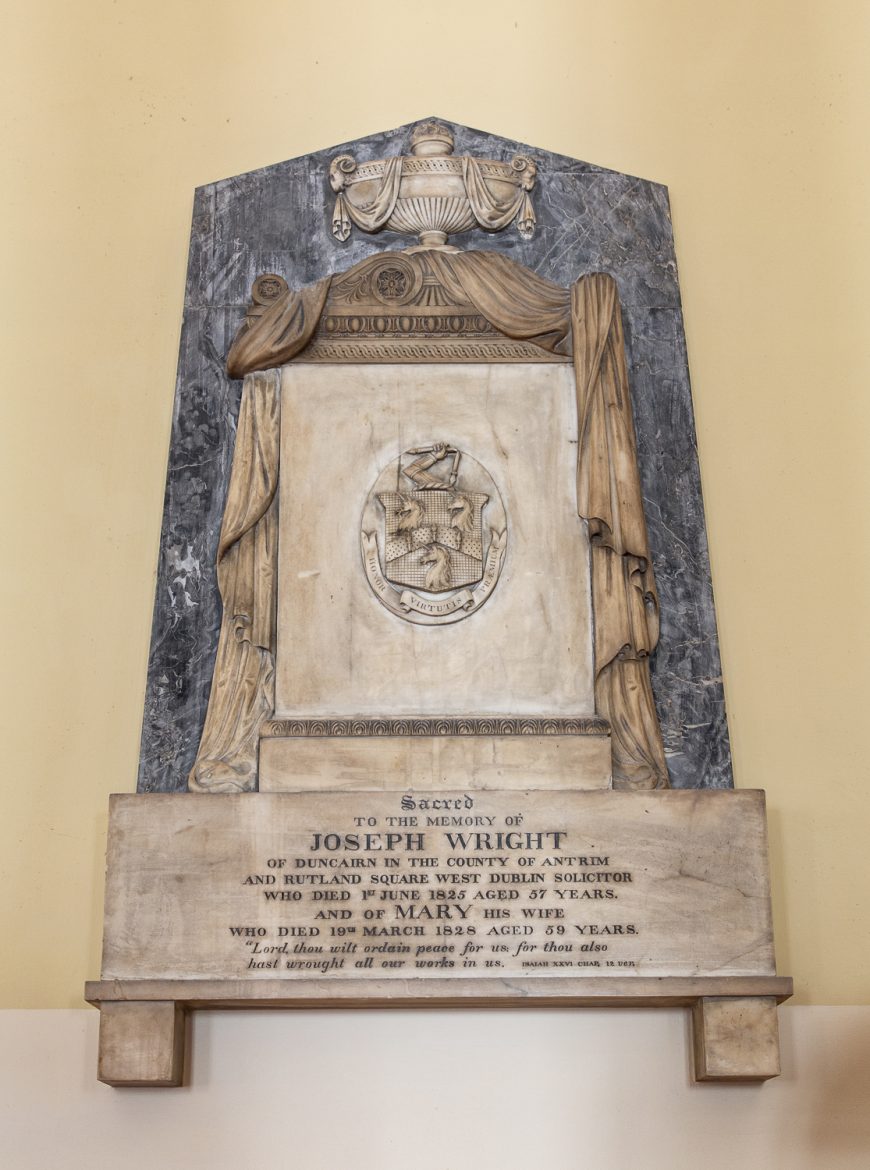
Self-Guided Tours
Available in The Church everyday between 10:30am and 5pm.
Welcome to The Church Café Bar. This is a self-guided tour around the building and grounds of the early 18th Century church of St. Mary’s.
History and background of the area.
The parish of St. Mary’s was founded in 1697 and was only the second parish on the north side of the River Liffey. It took its name from the medieval monastery of St. Mary’s Abbey that occupied most of the north side of the river from 1139 until its dissolution in 1539. The original Viking town of Dyflin was built on the south side of the river in the 10th century while only a small community lived on the north side. This community expanded greatly in the late 17th century at which point the parish of St. Mary’s came into existence.
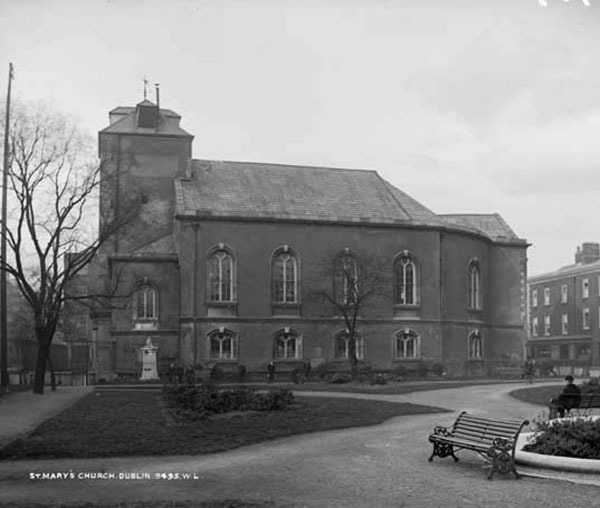
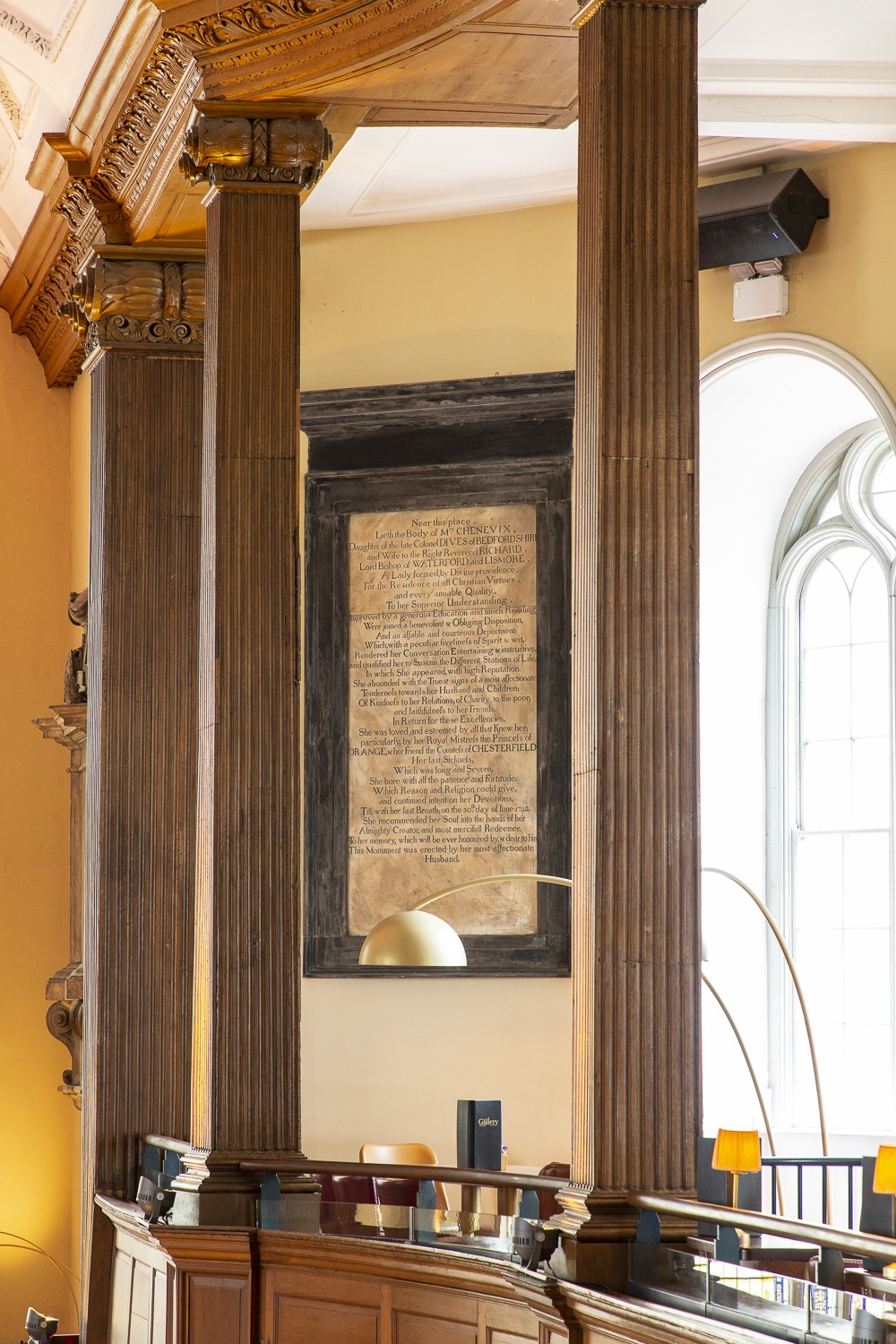
The Church Building.
Work on the church building began almost immediately and was largely finished by 1702. It was mostly the work of English architect William Robinson, who was also responsible for the Royal Hospital in Kilmainham. It is likely, however, that it was finished by his successor as Surveyor General, Thomas Burgh (also responsible for the Old Library in Trinity College). St Mary’s is currently most renowned as the first galleried church in Dublin and is a perfect example of classical church architecture. With the falling Protestant population and the change in the local area from residential to commercial use, St. Mary’s was finally forced to shut in 1986. The building was put to numerous uses over the next 20 years. It was then purchased by publican John M. Keating in 1997 and underwent a major refurbishment until 2005 and began trading as John M. Keating’s. Remarkably, until the changes made for its renovation as a café/bar, it possessed the oldest unaltered church interior in Dublin and much of this has been beautifully preserved. It was acquired by its present owners in 2007 and renamed “The Church”. Download a copy of our self-guided brochure here.
Stop 1 – Bust of Arthur Guinness.
The founder of the Guinness brewery in Dublin married his wife Olivia Whitmore here in St. Mary’s Church in 1761.They subsequently had 21 children,10 of whom survived ‘til adulthood. Arthur II, followed in his father’s footsteps and wed his wife Ann Lee here also. In front of the bust we see a fantastic example of a baroque stained-glass window. The framing of Portland stone shows a stylised design that bypassed most Dublin churches. The window itself exhibits a more elaborate pattern than usually seen in Protestant churches of that time where the stained glass was used more as shading than anything else. The gallery we see running around the interior of the church is the first of its kind in Dublin .This set a precedent as most Protestant churches followed this example over the next 150 years. The octagonal limestone pillars are timber clad and were extensively reconstructed during the conversion of the church in the late 90s.
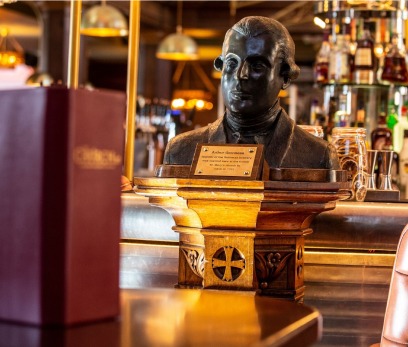
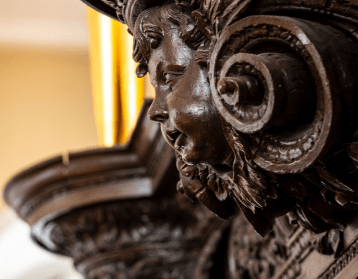
Stop 2 – Baptismal font below metal Spiral Staircase.
Several influential people were baptised in St. Mary’s Church including:
Nationalist and United Irishmen founder Theobald Wolfe Tone 1763
Irish playwright Seán O’Casey 1880
Alongside these famous names, there were more than 25,000 baptisms, 5,500 marriages and almost 18,000 burials at St. Mary’s Church.
Now walk up the metal spiral staircase.
Stop 3 – The Gallery
From the top of the stairs we get an excellent view over the whole converted church. We also see some of the 31 wall tablets, which are dedicated to people formerly buried in St. Mary’s crypt and graveyard.
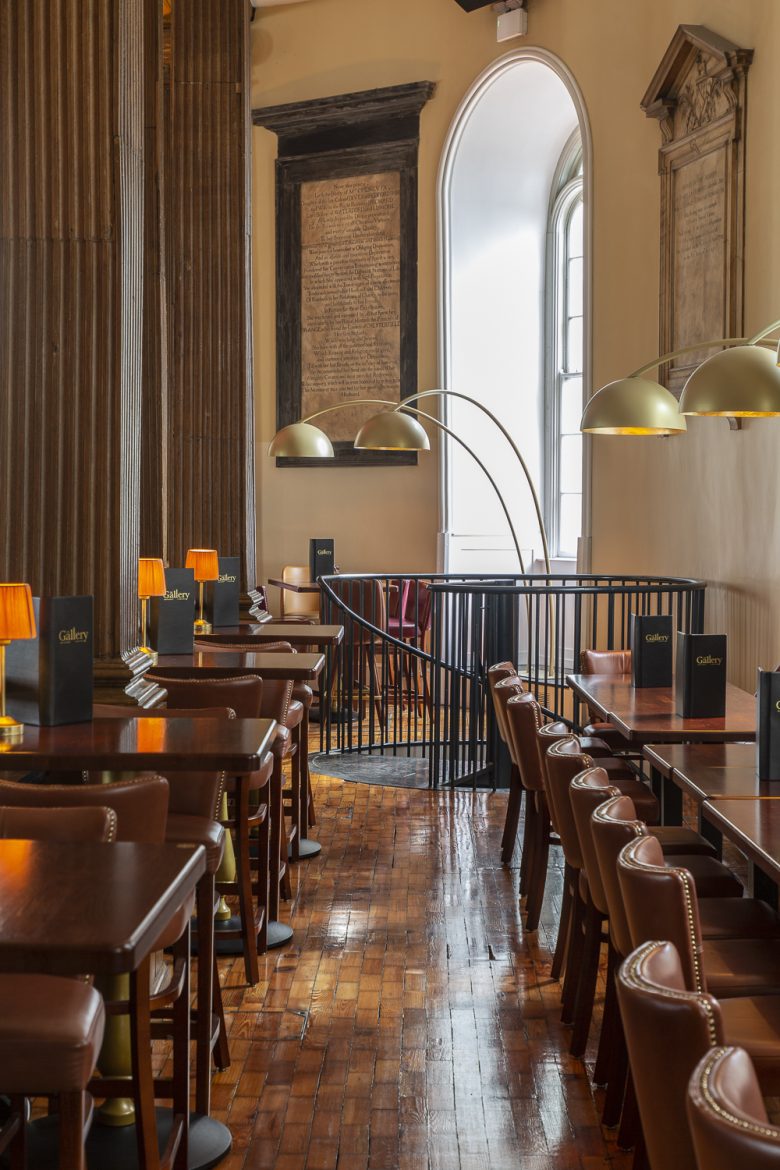
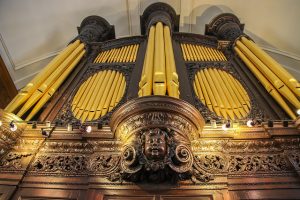
Stop 4 – The Renatus Harris designed organ
This is the most striking feature of the interior of The Church. Several of the figures on the organ casing were decapitated by an iconoclast but it is otherwise unaltered from the early 18th century. George Frederick Handel, of Messiah fame, lived on nearby Abbey St. and was a regular visitor to St. Mary’s to make use of the organ. There are two further tiny upper galleries on either side of the organ pipes though it is hard to imagine they were ever used. Though currently not functioning, it is hoped to get the organ back in working order soon though this will cost in excess of €100,000.We now continue walking past the kitchenette and bar area and around to the other end of the gallery and through the door to the external tower.
Stop 5 – The glass enclosed bridge to the Tower.
The wooden floorboards leading to the external tower were removed from the Adelphi Cinema/Theatre in 1995 prior to its demolition. Some of the famous acts to perform on its stage, including the Beatles and the Rolling Stones are listed on the floor below you. This tower provides lift access to all floors of the church as well as an emergency fire exit. Continue down the stairs past street level to the basement level.
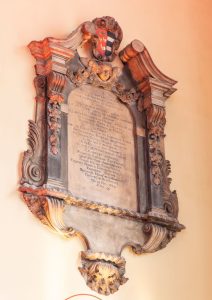
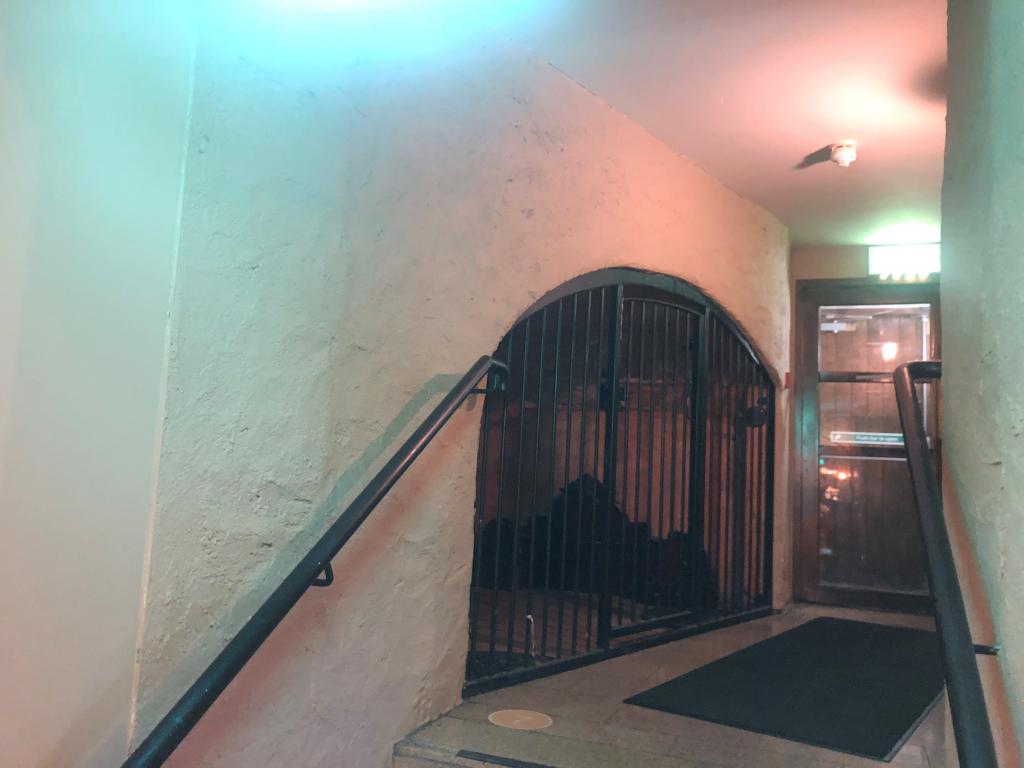
Stop 6 –Bar 1701
Continue forward about 20 metres and through the door on your left and enter The Cellar Bar. These function rooms are located in an area that was excavated out from underneath the Church. They are not part of the original building. Continue to the area (marked with an emergency exit sign) opposite the end of the bar counter and walk up the few steps.
Stop 7- The Burial Crypts.
There were 6 crypts in the basement of the church and extensive excavation work had to be carried out during the conversion of the church to its current use.32 skeletal remains had to be removed and reinterred elsewhere. Access to the crypts was from an external stairwell. Continue out of the Cellar and walk past the entrance to the toilets and go up the stairs to ground level. On the way you will pass one of the magnificent 18th century timber staircases which formed the original entrances to the upper gallery. All 18th Century churches followed this design of two staircases surrounding the centre organ.
Stop 8 -The original Entrance Porch
These two doors behind the display table were the original entrance doors to the Church. Note the wonderful wall sculptures. Now walk through the exit door which leads outside to the Terrace. The former Church Yard is now home to our Beer Garden and Al Fresco dining area. (The red brick building on the far side of Mary St. houses the beer cold room and store of The Church. This means that if you drink a draught beer in The Church that the beer has travelled underneath the street!
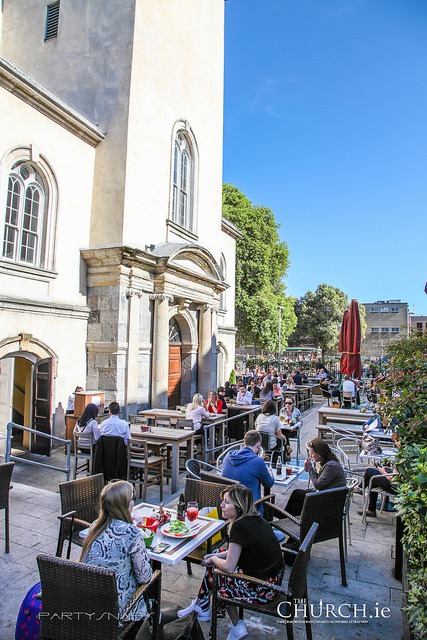
The terrace gives a splendid view of the original front entrance of St. Mary’s Church. The elegant Portland stone columns, with limestone surrounds, are elaborate for its period and certainly the most striking feature of the exterior. It is a later addition to the original church following its elevation as the parish church of the wealthy and powerful in the 18th century.
The stunted bell tower above the west front entrance is unfortunately the result of limited finances when the rich began to move to more fashionable areas on the Southside. The ‘temporary’ roof of the original construction is still in situ some 300 years later!
On the south side of the church building we find Wolfe Tone Park. This was once the site of the graveyard of the original St. Mary’s Church. In the centre of a burgeoning fashionable northside, the graveyard soon found itself overcrowded and as early as the mid-19th century bodies were removed to make more space – much to the annoyance of local residents who had to endure the spectacle and smell of putrefied remains! With its restricted space, few new burials took place here following the mid-19th century and by the 1940s the area was allowed to grow into a public park, with most of the gravestones being removed to the outer walls. This was made official in 1966 with the sale of the area to Dublin City Council and the removal of the headstones. Many of the original gravestones are still visible on the southern wall of the public space today.
The graveyard became the final resting place of several eminent Irish figures. Most notable amongst these being Lord Norbury – the infamous “Hanging Judge”, who sentenced Irish nationalist Robert Emmet to be hung and beheaded following his failed rebellion in 1803.
So that is “The Church” A Great Dublin Experience!. We thank you for visiting and we do hope that you have enjoyed the art, architecture and history on this tour. We suggest that you now find yourself a comfortable seat and relax and enjoy some of our Irish hospitality. And if you would like to return later to dine in the Gallery Restaurant we suggest that you make a booking at the reservations desk. Bookings are not required for drinks and/or dining in the main Bar.
